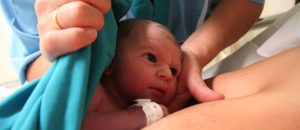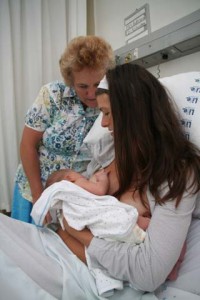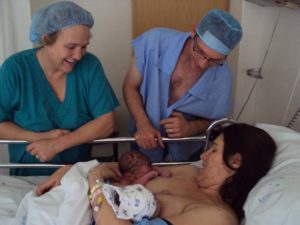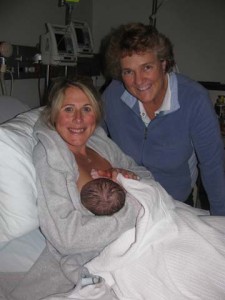Kangaroula
Kangaroo mother care plus doula
equals KANGAROULA.
This photo shows exactly why I love to do what I do:
The magic of the open eyes connecting with Mum, the first bonding. The baby is calm and peaceful, wide-awake and brain wiring for emotional security.
As Kangaroula I am shielding his eyes from bright lights, keeping him in skin to skin contact on Mum’s chest, supporting his head, facilitating the connection to mum, trying to keep this special time uninterrupted for early breastfeeding, and asking nurses to keep noise levels low.
I am also watching a quiet miracle of a lovely lady become a mother, and a special couple becoming a family. What an awe-filled and incredible privilege to share this wonderful time with parents!
What is a Kangaroula?
A Kangaroula is advocating for the baby, speaking for the tiny baby that has no voice and needs to cry to get across the message that he is expecting his basic biological needs to be met. The most fundamental biological need is to feel safe!
The Kangaroula provides care focused on the needs of the newborn baby and his/her brain in the first hours of life. It is based on the most recent findings from developmental neuroscience, that we now call nurturescience. The Kangaroula also helps to make the change from life inside mum into the open world as smooth as possible for the newborn baby. This helps early parenting start well.
The doula supports the mother through the labour to birth. The “kangaroula” (kangaroo + doula) supports the baby and mother dyad from birth to bonding.
This begins with skin-to-skin contact in full term birth, in labour ward or in theatre (OR) for Caesarean section: no matter where birth happens skin-to-skin contact on mother is the right place for baby.
IT MATTERS HOW WE ARE BORN
The first 1000 minutes after birth are critical to making this journey a happy and rewarding one, or a tough slog. What we offer from NINO is the extension of the doula into this FIRST THOUSAND MINUTES, combining the doula function with the nurturescience, expressed through kangaroo mother care and immediate skin-to-skin contact. Hence, the doula is not just for the mother, but also for the baby, and so we have the KANGAROULA. In its beginnings “Kangaroo Mother Care” was something for small babies, born preterm or with low birth weight. The neuroscience shows clearly that skin-to-skin contact is the basic and normal place of care for ALL BABIES, even if they are “big and strong”. It is because of this that it works so well for small babies: the smaller the baby is, the more it needs the right place for its care. Skin-to-skin contact without separation is for EVERY BABY. Care for PREMATURE BABIES relies on incubators. Yet, there is NO EVIDENCE that incubators “do good”, they just do what they do, which is to warm and humidify. Mother’s chest warms and humidifies much more efficiently and better, as well as providing better heart, lung’ stomach and kidney functions. Above all mother’s sensations fire and wire emotional and social intelligence in the baby’s brain. There are over 4000 published papers (2020) all stating that skin-to-skin contact is better than incubator. But since incubator is “normal” nobody takes notice. Skin-to-skin contact is absolutely vital for your premature baby. Early parenting starts at birth!
In the olden days people used to believe that the newborn baby could not hear or see or think or remember, that it was hardly conscious. That is absolutely wrong. The Swedish Professor of Paediatrics, John Lind, wrote:
“Personally I feel that one of the biggest discoveries in the field of pediatrics in my time is the concept that the newborn child is a small human being, with all its senses developed open and receptive”.
AS A KANGAROULA I SUPPORT THE BABY AT BIRTH BY:
- facilitating birth skin to skin contact to help the baby to stabilise as quickly as possible physically and emotionally
- helping to keep mum and baby together and to minimise separation which causes huge anxiety for both mum and baby
- helping to make the birth environment as gentle as possible to minimise stress for the baby
- speaking for the baby best benefits, explaining the natural biology of birth for the mum
- helping the baby to be in the right place to latch and feed-in the first 60-90 minutes- wherever possible.
- expression of colostrum in the first hour if baby not suckling
- helping and encouraging and informing mums with early breastfeeding
- encouraging the dad to hold his baby skin to skin to have time to bond.
- supporting mum and baby to have time and a safe space to bond which leads to attachment and helps build a healthy relationship with your child.
- informing parents of the best options from the BABY’S perspective
IN THE FIRST 24 HOURS I ENCOURAGE
- SKIN TO SKIN CONTACT
- small, frequent breastfeeds and feeding on demand.
- safe co-sleeping.
- mum to read her baby’s small stress signals and sleep states
- and support mum and baby at a home visit in the first few days.
IF A BABY IS BORN PREMATURELY I SUPPORT
- Parents to do skin to skin contact as much as possible.
- mum to express breast milk and breastfeed her tiny baby as early as possible, and frequently.
- Parents and staff in the NICU with developmental care to minimise baby’s stress
- parents with counselling as they struggle with their emotions of their baby’s premature bith
- NICU staff with evidence-based practice
More details!
Our care might most closely resemble that of the “doula”; however, while the doula supports the mother through the labour to birth, the “kangaroula” (kangaroo + doula) supports the baby and mother dyad from birth to bonding. This concept has been prompted partly by requests from parents, who are well-informed and up to date with these modern trends. This state of the art thinking was long practised in Sweden in the Karolinska Institute, where the terms “family-centred care” and “couplet care” are used, the March of Dimes in the USA is promoting very similar care; and the NIDCAP movement has developed this understanding of the neuroscience specifically in the context of prematurity.
The Kangaroula applies nurturescience – Dr Bergman’s synthesis of developmental neuroscience. The newborn brain is highly plastic, and adapts very rapidly to the earliest environment it experiences. The baby’s brain is expecting familiar sensations of smell, touch and soothing voice, only provided by the mother. When there is skin-to-skin contact, the autonomic nervous system of the mothers and baby are connected, and physiological regulation takes place in the baby. But even more significantly it is now clear that emotional and social intelligence begins through skin-to-skin contact in this first hour also. Very early breastfeeding and colostrum plays a major role in both these processes. The mother’s emotional experience powerfully influences her own physiology and her perception of care. Optimal birth experience for the whole family is the key.
Our modern obstetric and neonatal care is of the highest technological quality, and ensures survival of mothers and babies. In the process, specialization has resulted in this care being fragmented, separating mothers and babies. This separation is experienced negatively by parents, but also has harmful effects on newborn development. The kangaroula is able to provide a holistic and integrated support that spans all departments in which the mother and baby find themselves, with the objective of avoiding or minimizing separation.
It is the quality of the parental experience , and the quality of their baby’s brain development which the Kangaroula will improve. This would not duplicate or replicate any current care, but would support the timing and delivery of this in such a way as to focus on optimal birth experience.
The kangaroula works closely with the staff but does not interfere on the medical care side of things, but does “translate” for the parents what the nursing staff are doing and saying about their baby, explaining if things are a problem, and supports both mum and baby being together, bonding, attachment and early breastfeeding.
The environment of the Neonatal ICU can be very strange, overwhelming and scary for parents of prematures and that is why Jill and Nils have written the book Hold Your Prem.




